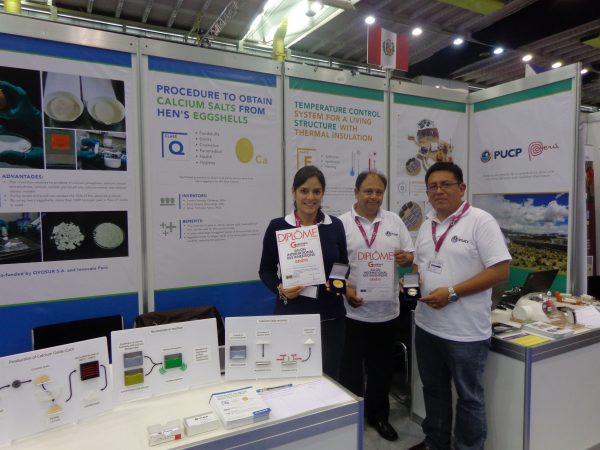
Two inventions made by PUCP researchers were presented at the 46th International Exhibition of Inventions of Geneva and were awarded with gold and silver medals. This event is held annually and it is organized by the World Intellectual Property Organization (WIPO), one of the specialized agencies of the United Nations
MEDALISTS
The invention that won the gold medal in Geneva is called “Procedure to collect calcium salts from eggshells”. This project, developed in Laboratory of Industrial Processes, was conducted by the researchers of the ITEPA Group Mg. Sandra Sarango, Mg. Erick Álvarez and Dr. Omar Troncoso, in collaboration with the company Ovosur. The inventors defined the concentration of calcium carbonate as the main component of eggshells, with a purity level superior to 95%. The, they pulverized it and calcined it to obtain calcium oxide; in that way, when this gets mixed with other kinds of acids, we get calcium salts that work as a food additives. In other words, all these eggshells that we usually throw away after frying or boiling an egg, can be used to fortify foods that will help us keep healthy bones and muscles.
On the other hand, the silver medal was awarded to the project “Temperature control system for livable structures”. This originated in 2015, when the company Domos Peru met with the PUCP to organize an event that would help find solutions to the cold waves that affect low-temperature areas. In this way, Enrique Barrantes, Ronald Más and José Miguel Pérez, researchers from the Energy Laboratory and from the Group of Innovation in Energy and Environmental Technology (GI-Team) at PUCP, along with the researches from Domos Peru Manuel Domínguez and Duberlis Correa Peña y Lillo, created a system from renewable energy.
“Basically, it consists of harnessing solar energy: accumulate it thermally, and then transform it into electric power for the elements of control and distribution of thermal energy inside a dome –which has insulating layers- to keep comfortable temperature levels between 20°C and 25°C (58°F to 77°F) during extreme temperatures of -5°C and -10°C (23°F to 14°F)”, explains Enrique Barrantes. This invention was tested in Mazocruz, a town in the Puno Region, which is one of the places that undergoes the impact of low temperatures.
Intellectual Property Office
The inventions exhibitions in which the PUCP participates allow it to show our society that this is an institution dedicated to generating novel technologies in different technical areas. For that reason, it is very important to keep encouraging the participation of students in exhibitions like the one that took place in Switzerland.
“This not only motivates them as inventors: it also opens doors to new opportunities in research or even to jobs”. This, therefore, has a positive impact on our academic community, since students get more opportunities when researching and developing new technologies” states Arlon Castillón, coordinator of the Intellectual Property Office.
We owe a huge part of the success of the inventions to the professors and researchers that are committed to participate actively in the development of the inventions and the exhibition of said inventions on technology events. “The other important contributions comes from the PUCP, since it provides financing and technical and legal support through the Intellectual Property Office (OPI in Spanish). The OPI not only plans the logistics of the presentation of PUCP inventions, it also offers assessment and is in charge of the preparation of the documentation that is required to register their events in Peru and abroad, with prior authorization from our authorities”, explains Castillón.
Source: Punto Edu Web
Image: Oficina de Propiedad Intelectual PUCP